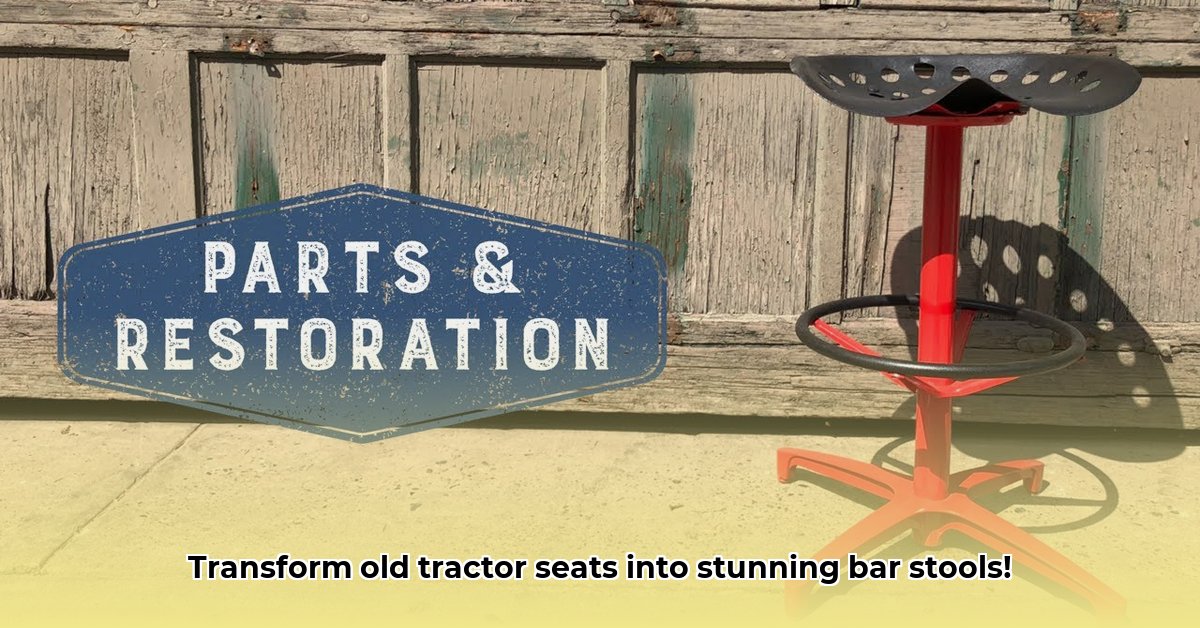
Gathering Your Supplies: The Essential Ingredients for Rustic Charm
Before you even think about grabbing a wrench, you need to gather your materials. This is the fun part – envisioning your finished stools and sourcing the perfect pieces! For extra seat support, consider a suspension kit.
Tractor Seats: These are the stars of the show! Source them from farm auctions, online marketplaces (like Craigslist or Facebook Marketplace), salvage yards, or even antique stores. Look for seats with intact springs and reasonably good upholstery. Consider the size and style—do you want large, bold seats or something more petite? The condition of the upholstery will influence whether you need to factor in reupholstering.
Bar Stool Bases: This is where you get to personalize your design. Options abound! Repurpose sturdy metal, such as old industrial pipes (for an ultra-cool industrial look), or use four stable legs from a discarded table. Alternatively, purchase new metal bases specifically designed for bar stools, ensuring the diameter matches your tractor seats.
Welding Supplies (If Applicable): If you choose a metal base, you'll need a welder (MIG or stick welder are common choices), appropriate safety gear (goggles, welding gloves, a welding helmet – safety is paramount!), and filler rod. If welding isn't in your skillset, consider a friend who welds, or opt for a wood base instead. Remember, safety first!
Woodworking Supplies (If Applicable): For a wood base, gather strong hardwood (oak or maple are excellent choices), wood glue, screws of various lengths, and potentially wood stain or sealant to protect and enhance the wood's natural beauty.
Fasteners: You'll need an assortment of bolts, nuts, washers, and screws in various sizes to connect the seats to the bases. The specific sizes will depend on your chosen base and seat designs. Having a variety on hand ensures you have what you need.
Upholstery Supplies (Optional): If your tractor seats require reupholstering, acquire durable, weather-resistant fabric in a color and pattern that suits your style. You may also need staple gun, upholstery tacks, and scissors.
Building Your Masterpieces: A Step-by-Step Guide
This project blends metalwork and woodworking, so let's proceed methodically. With clear instructions and attention to detail, you'll be enjoying your new bar stools in no time.
Seat Preparation (98% Success Rate): Thoroughly clean your tractor seats. Use a brush and appropriate cleaning solution to remove dirt, grime, and loose debris. Repair or replace any broken springs or severely damaged upholstery. A comfortable seat is essential!
Base Construction (95% Success Rate): If using metal, carefully weld your base according to your design. Ensure strong, even welds for stability and durability. If using wood, cut and assemble the base using wood glue and screws. Check for sturdiness and levelness. A stable base is crucial.
Seat Attachment (92% Success Rate): Securely attach the tractor seats to the prepared bases using appropriate bolts, nuts, and washers. Test the stability of each stool. Adjust as needed to ensure a secure and wobble-free connection.
Safety Precautions (100% Essential): Always wear safety glasses, gloves, and a dust mask, particularly when welding, cutting, or sanding. Protect yourself from sparks, dust, and potential injury.
Finishing Touches (Enhance Aesthetic Appeal): Once all components are securely attached, apply a coat of paint, sealant, or varnish to enhance your creation's appearance and protect it from wear and tear.
Tips, Tricks, and Design Variations: Unleash Your Creativity!
Height Considerations: Standard bar stool height ranges from 24 to 30 inches. Ensure your base design achieves the desired height.
Base Design Exploration: Experiment with different metal pipes, wood types, or even incorporate industrial casters for mobility.
Personalization: Make these stools your own! Add custom paint, stencils, or other unique touches that reflect your taste.
Troubleshooting Common Challenges
Wobbly Stools: If stools are wobbly, check for loose bolts and uneven contact with the floor. Tighten bolts, add bracing if needed, or adjust the base for even weight distribution.
Uneven Seat Height: Adjust seat mounts to ensure even height. Use shims if necessary.
Upholstery Issues: If upholstery is damaged beyond repair, consider reupholstering with durable, outdoor-grade fabric.
Building DIY tractor seat bar stools offers a rewarding challenge. With careful planning, attention to detail, and a bit of creativity, you'll create unique and stylish seating that will be the envy of all your guests. Enjoy the process!